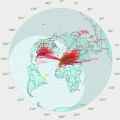v1.390: cross compilation, SAM demodulators
From the "I'm not working on it except when it interests me" department:
v1.390 April 23, 2020
Performance improvements:
Suggested by @howardsu on Kiwi forum: remove -DDEBUG so assert()'s are not evaluated.
Added new "make debug" target to revert to compiling with -DDEBUG defined.
Christoph's cross-compilation changes: added "make xc" target that allows cross-compiling on
development host. Alternative to slow compiles on Beagle during development.
See file CROSS_COMPILE for complete details.
Added synchronous AM (SAM) demodulators from Warren Pratt's wdsp package via the
Teensy-ConvolutionSDR implementation: github.com/DD4WH/Teensy-ConvolutionSDR
See the Kiwi operation manual for more information: kiwisdr.com/quickstart/index.html#id-faq-sam
Synchronous AM modes: SAM, SAL, SAU, SAS
User interface changes:
Use keyboard shortcut 'A' to toggle the SAM modes (sorry, 's' and 'S' were taken).
As always type 'h' or '?' to see the list of all keyboard shortcuts.
Bugfix: Adjusting the passband via a "/width" or "/low,high" entry in the
frequency box is now "sticky" i.e. remembered when returning to the mode.
Just like when changing the passband via the 'p' and 'P' keyboard shortcuts.
Restore as usual by shift-clicking on the mode button.




Comments
Its fun to get close to a signal and hear the SAM tune in the frequency.
I tried BCB, but can't find much to listen to...
Thanks so much for the implementation. .
Works great - a good test is to find a strong local MW BC station with a weak adjacent channel signal that is normally obliterated by the stronger local and then click on SAM or SAL (depending on which side of the stronger signal it is situated) and bingo there it is nice and clear!
Thank you for the great update!
-Zyg- AF4MP
Nice job with the SAM inclusion.
It'll be interesting to try the cross compilation as well, but that's a few weeks away for me.
It works perfectly tuned into a broadcast station in MW. Great sound, love it.
If I listen to my own Talking House Part 15 Transmitter, I get an occasional clunk/glitch sound in the audio, which I notice coincides with a sudden shift in the carrier frequency of a few Hz. I assume this is the fault of the TH transmitter itself, its PLL is probably shifting the carrier frequency.
I did notice that the SAM frequency offset indicator on the "Stats" screen will sometimes not appear: Switching to AM and back to SAM will usually make the status indicator appear. Once in a while the offset indicator will stop updating - even though the demod is working fine - but in that case it sometimes seems to require a page reload to get it working again.
Thanks for the great work!
Clint
Update, wasn't imagining it... the yellow passband doesn't always update
You'll only see it changed if you had previously altered the passband for the particular mode (all 4 SAM modes are treated independently in that regard just like e.g. AM and AMN). Remember that such a change is "sticky" until you undo it with shift-click on the mode button to restore the default passband (tooltip when you hover over mode button with shift depressed will say "restore passband").
https://github.com/DD4WH/Teensy-ConvolutionSDR/wiki/Binaural-audio-=-pseudo-Stereo-demodulation
Already fixed for the next release..